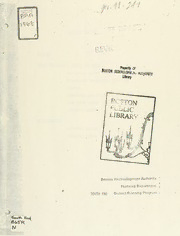
South end. (draft) PDF
Preview South end. (draft)
toji'i-v rJi'M'^ 1 uj Boston Redevelopment Authority r Planning D^partn'icnt j, SOUTH END District Planning Program t. "^OKA+K End N TABLE OF COf.TEKTS HISTORY SOLTTH BID TODAY - ISSUES A'iD iiEEDS POPUUTION SHIFTS DEMOGRAPHIC PROJECTIONS 1970-1985 HOUSING CO^Y'ERCIAL AREA DECLINE LONG RANGE ISSUES COmUNIPi' GROUPS NEI6HB0RHDDS NORTHERLY SECTOR SOLTTHERLY SECTOR /""^-...-" / ./ / r I *--*, •\ r \ ..^ \ \. "-^ X. X \ / AST I:. 2 CHARij::.. ' •_ I ^ l5MATTAPAN-FRANKLir SOUTH END A Short History Developed more than a century ago as a wealthy residential community, the South End quickly succumbed under the stresses of the financial panic of 1873 and the subsequent emergence of the Back Bay as Boston's most fashionable neighborhood. The elegant Victorian single family townhouses v;ere rapidly converted into v;ay stations for poor immigrants and into lodging houses for the dispossessed. By the late 1950' s, the South End had become a microcosm of mid-twentieth century urban life, plagued with the problems of dwindling population, poverty and decay that typified old inner-city neighborhoods throughout the country. Yet for many of its residents, the district was a viable, low rent area of the city for the lodging house tenants, the elderly, first and second generation families of middle- and far-eastern origin, and the recently arrived Southern Blacks and Spanish-speaking, concen- trated for the most part in homogeneous enclaves and sub-communities scattered throughout the area. Some form of community renewal was urgently needed, however, and in 1960, the key to the Development Program was the rehabilitation of Boston's deteriorating neighborhoods. The focus of Urban Renewal in the South End was rehabilitation on a very large scale. Unlike most other urban neighborhoods, however the South End has a unique architectural integrity, coupled with its proximity to downtown, that provided the potential for the development of an attractive middle- and upper-middle class neighborhood. By the mid-1960's, private developers and higher-income families were beginning to purchase and rehabilitate the old brick townhouses in substantial numbers. After four years of extensive negotiations, the Urban Renewal Plan was approved in 1965, and feared by some and encouraged by others, the arduous and lengthly process of implementation began. In attempting to be re- sponsive to a multiplicity of interests within the community as a whole, the Plan set forth two primary objectives that were in apparent contra- diction with one another: the rehabilitation of existing housing, and insuring the availability of standard housing at rentals that all dis- placed low income residents wishing to remain in the South End could afford. To this end, over 4,000 low and moderate income apartments have been built or rehabilitated, and schools, parks and extensive public improvements have been or are in the process of being completed. Yet, after a decade of renewal activity, the seeming incompatibility of these two primary objectives remains a continuing source of conflict between the diverse factions within the community. South End Today - Issues and Needs Population Shifts Although the population of the South End declined from 57,000 in 1950 to 23,000 in 1970, the racial distribution has remained relatively stable since 1960. Today the ratio is about 46 percent white, 40 percent Black and 12 perecent oriental. Spanish-speaking residents constitute about 7% of the population. As of 1970, almost half of the households in the South End are single person households, and about three-quarters of all households are eligible for public housing. Within the v;hite population, the number of higher income professionals has increased, while there has been a decline in the lower income and working class segments, as well as in the number of elderly poor. The median family income rose 65 percent from 1960 to 1970 (from $3,650 to $6,050), reflecting the recent influx of middle class residents and the outward movement of poorer households. This influx, for the most part, is due to the proximity of the South End to the Prudential Center, Copley Square and Back Bay to the northwest, as well as the rapid increase in the amount of new office space in the Central Business District, and has resulted in a sharp rise in property values in large sections of the area. Total 1970 Change '60-70 Black '60 Black '70 % Over 60 0-17 22,605 -35% 39% 39% 20% 27% Median Income % Families Under 5,000 $6,266 40% Demographic Projections 1970-1985 Continued market rate rental rehabilitation will result in an increase of middle income single persons which will more than offset losses due to rooming house conversions. At the same time, subsidized new construc- tion and rehabilitation, as well as the increased attractiveness of the South End to middle income families interested in being homeowners, will result in an increase in the number of persons in families. A small decrease in the elderly population is expected over the next ten years, as the result of conversions and increased elderly housing oppor- tunities which will become available in other areas of the city. The South End, however, is still expected to have a higher proportion of elderly persons than the city as a whole. Finally, median family income in the South End is expected to increase substantially by 1985, as measured by dollars of constant value. This will be a result of both real income increases for lower income residents and continued immigration of middle upper income families. Despite this projected increase, the South End median family income will be 15 percent less than the city median and the third lowest of all planning districts.
